Ask the Manners Guy: Keep Nature Clean
Finding the Sweat Spot
Even before coronavirus, I was the only one at the gym, it seems, who wiped down equipment. Am I overdoing it? —Nettled in North Carolina
You’re one of the good ones. At most gyms, employees clean the equipment multiple times throughout the day. Even so, it’s a common courtesy to sanitize surfaces after you use them to prevent the growth of potentially harmful germs. It’s also a good idea to wipe down equipment before you use it. Be the change you wish to see in the weight room.
Nature Maid?
I love the outdoors, but I’m not a seasoned backpacker. On my last foray into the woods, I noticed a fair amount of litter, and lots of people talking into their phones. What’s the etiquette here? —Irritated in Indiana
Dropping garbage in the woods is a violation of the first rule of the outdoors: “Leave no trace.” That means pack out everything you brought in; don’t mar the landscape with fires outside of designated fire pits; and stay on the trail at all times. Cellphone use in the great outdoors is a somewhat novel annoyance. By all means, carry a phone as a safety precaution, but no one wants to hear you livestreaming to your followers or jabbering loudly about your fantasy football league in the middle of a pristine forest.
The Manners Guy is a former bartender who knows his way around awkward social situations. Send your questions to [email protected].
This article is featured in the July/August 2020 issue of The Saturday Evening Post. Subscribe to the magazine for more art, inspiring stories, fiction, humor, and features from our archives.
(Lincoln Beddoe / Shutterstock)
Wellness Escapes: Amazing Hiking Destinations to Boost Your Health
Looking for the latest wellness trend to boost your health and fitness? Forget expensive spa treatments and extreme juice diets — the best thing you can do for your health today is to get out into nature and onto the trail!
In recent years, hiking has received a great deal of attention as a result of its holistic health benefits. In addition to being a full body, challenging workout, hiking has been shown to have fantastic benefits for mental health, physical health, and general wellbeing. Heading for the hills can boost your mood, reduce blood pressure and cortisol levels, help you get a good night’s sleep, and leave you feeling reinvigorated and re-energized. And many hikes can be accomplished while “social distancing” from other hikers.
Hiking is a highly accessible physical activity that can be taken up by most people, whatever your fitness level. As well as improving your physical and mental health, hiking is an excellent way to reconnect with nature, allowing you to immerse yourself in the natural environment and become more self-aware and present in the moment. It’s the perfect antidote to our busy, stressful, urban lives.
What’s more, the United States is known for its incredible hiking destinations, packed with epic landscapes and views that will make your heart soar! Here are some of the most amazing hiking destinations in the U.S., together with tips on how a visit here could seriously boost your health.
Be sure to check with parks before visiting, and some parks are completely or partially closed at the time of this writing due to the coronavirus.
Glacier National Park
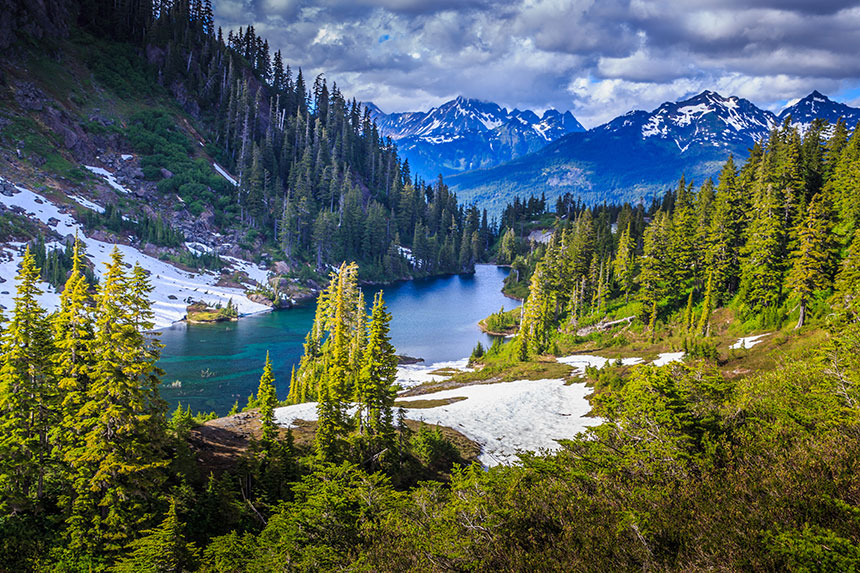
Looking for a way to combine a wilderness escape with a wellness retreat? Head for Glacier National Park, where you’ll find plenty of yoga and relaxation retreats combined with epic hiking opportunities in one of North America’s greatest wildernesses. This majestic corner of the Rocky Mountains is the ideal place to come to gain a little perspective — the sight of these colossal, craggy mountains will make all your problems feel very small indeed.
Glacier National Park covers nearly 1,600 square miles of stunning terrain. You’re sure to see plenty of the eponymous glaciers, which have shaped the region over the millennia and which can be heard creaking as they slide inch by inch down the mountainsides. Hiking in Glacier National Park is pure paradise for adventure seekers, with thrilling ridge walks, expansive wildflower meadows, and glittering alpine lakes. Expect jaw-dropping views around every corner.
Perhaps unsurprisingly, Glacier National Park has emerged as a hub for wellness retreats, as more and more people discover the benefits of spending time in natural spaces. If you’d like to try your hand at yoga or meditation, these activities can easily be combined with a hiking trip if you head for Whitefish, a lively town that operates as the gateway to the park.
Whatever you choose, a hiking trip in Glacier National Park is the ideal way to shake off the cobwebs, stretch your legs, and clear your mind. To give you a little inspiration, here are some tips on all the best hikes in Glacier National Park.
Arches and Canyonlands National Parks
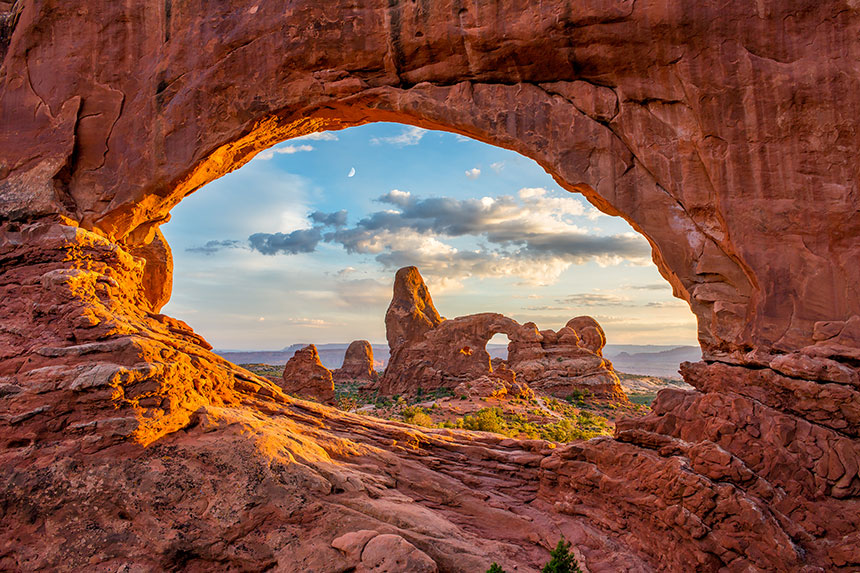
The southeastern corner of Utah might seem like a strange destination for a wellness escape, but the area around Moab has recently emerged as a hub for fitness enthusiasts. The Arches and Canyonlands National Parks are just a stone’s throw from Moab and both offer fantastic possibilities for hiking, mountain biking, trail running and climbing.
Visiting this region can feel like a journey to another planet. Gravity-defying sandstone arches tower over the trails, glowing deep red under the strong desert sun. In some places, the ground gives way to plunging canyons, carved over centuries by the relentless passage of the Colorado and Green Rivers. You’ll find otherworldly rock formations, endless forests of sandstone pinnacles, and unusual desert flora everywhere you go.
If you’re looking for a good destination for an active vacation, a chance to try a new sport, or a fun fitness challenge, Moab is the ideal choice. You’ll find plenty of fun activities here, with excellent tour guides and local companies that will help make your trip a memorable one. What’s more, the trails in Moab are easily accessible and suitable whatever your age or fitness level. Whether you’re seeking a strenuous challenge to help you hit those fitness goals, or simply want to take a stroll in some remarkable landscapes, there’s a trail here for you.
Check out this guide for details of all the and start planning your next activity holiday today!
The Hoh Rainforest in Olympic National Park
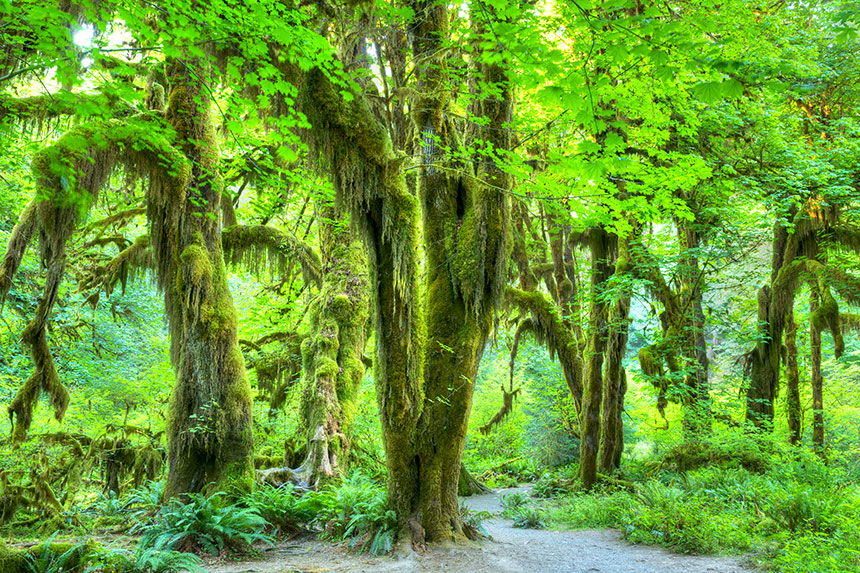
Recent studies have shown that hiking in natural spaces, and forested or wooded environments in particular, can have fantastic effects on our mental health and general wellbeing. In fact, several cultures have a long history of forest immersion as a way to promote relaxation. Most notably, the Japanese practice of shinrin-yoku, or forest bathing, has recently come into vogue in North American wellness circles, but this is a tradition that has a long history in different parts of the world.
If you’re looking for a truly special forest that will stimulate your senses, reconnect you with nature, and help you to unwind, head for the Hoh Rainforest. This lush, temperate rainforest can be found in Washington State’s Olympic National Park, and walking through it will transport you to a land of myth and mystery. The ancient trees are clothed in thick, fragrant lichen, and a wide variety of mosses and ferns hang from the forest canopy. This unique forest sustains a rich ecosystem, and if you linger beneath the trees you’re likely to see a wide range of plants, birds, mammals and insects.
Hiking through the Hoh Rainforest is a deeply meditative, peaceful experience. This is a wonderful way to experience the diverse wildlife of the Olympic National Park, from the smallest tree frog to the imposing elk that come to nibble at the lettuce lichen growing on the ancient trees. See this guide to the Hoh River Trail for more information, and don’t forget to factor in a night camping at the popular Five Mile Campground, where you’ll be lulled to sleep by the sounds of the forest.
Lassen Volcanic National Park
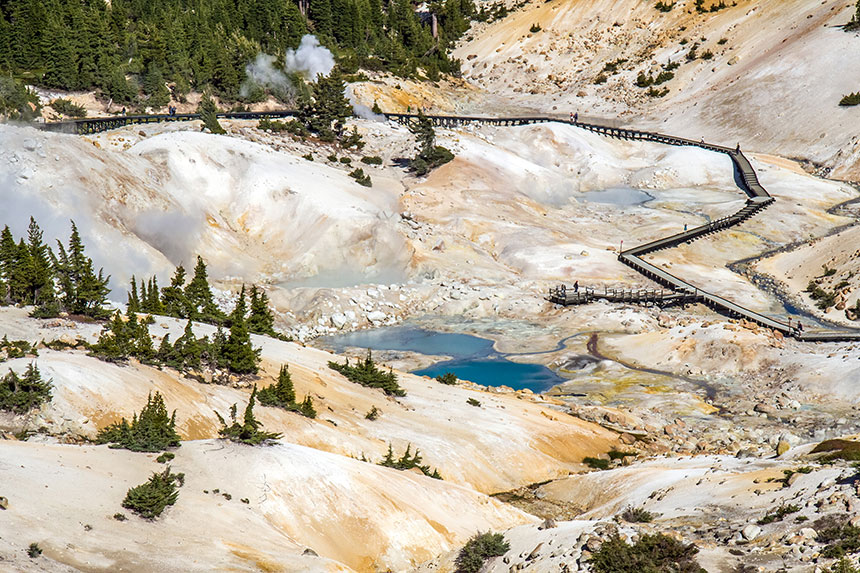
Formed in the crucible of volcanic activity, the dramatic landscapes of Lassen Volcanic National Park form the perfect backdrop for an epic hiking trip. This strange terrain, shaped over millennia by fiery volcanic eruptions, is littered with accessible hiking trails, perfect for hikers of any ability and fitness level.
Lassen is a land of fire, and wherever you go in the park, you’ll come across steaming fumaroles, vents, mud pots, and hot springs. For millions of years, volcanic activity has shaped this landscape, creating towering peaks and lava beds, such as those around Cinder Cone. However, you may be surprised at how green and lush some parts of the Lassen wilderness are — this is a region of gushing waterfalls, crystal clear lakes and rushing streams, all fed by the annual snow melt from the higher peaks.
Lassen is one of California’s great wilderness areas, which means it’s one of the best places in the world for stargazing. No artificial light will interrupt your view of the night sky, and this is a fantastic place to come to learn more about astronomy. Every year in August, scientists, astronomers and enthusiasts flock to Lassen for the Dark Sky Festival, making it a wonderful time to visit on a hiking trip. Enjoy the hiking trails and volcanic features by day, and at night you can sit back and contemplate all the mysteries of the universe.
North Cascades National Park
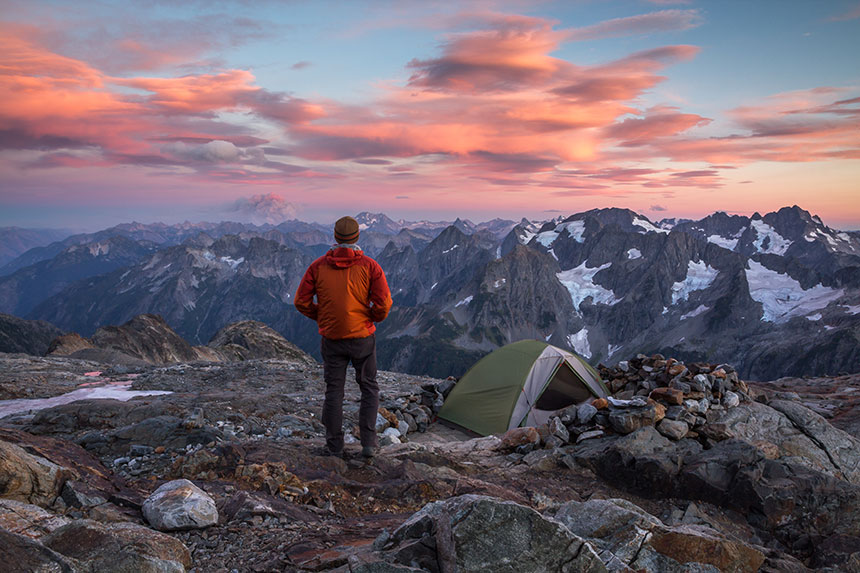
Want to really get away from it all? The United States is home to some vast areas of wilderness, but arguably none are so beautiful as the North Cascades National Park. With over 400 miles of trails set in 1000 square miles of uninterrupted backcountry, this is the place to come if you want to leave the daily grind behind and head out into the wild.
The North Cascades range boasts thrilling peaks, ridges and valleys, with opportunities for some seriously spectacular views. You’ll be hiking through meadows strewn with wild flowers, scaling craggy ridges, and relaxing by the side of glittering alpine lakes. You might be accompanied on the trail by a few bighorn sheep or curious deer, and if you’re lucky, you may even catch a glimpse of the elusive gray wolf, wolverine or black bear.
The North Cascades is a wonderful place for a truly immersive hiking trip. Getting out on the trail here could give your health a serious boost, allowing you to improve your fitness, boost your mood and sense of wellbeing, and reconnect with the majesty of nature. For a little inspiration, check out some of the best hikes in the North Cascades National Park, and start planning your next hiking trip today!
Featured image: North Cascades National Park (Shutterstock)
The Benefits of a Good Walk
The very act of lacing up her boots for her daily hike brings back fond memories for Michele Straube. Her parents, German immigrants, took the family on long, meandering walks in the woods nearly every Sunday afternoon. (The Germans even have a word for such walkabouts: wanderung.)
Michele does her wanderung these days in the foothills of the Wasatch Mountains near her Salt Lake City home. It’s about fitness, sure, but it’s also a form of release. “Out in the open spaces, hiking takes you to beautiful places,” the 57-year-old says. “It’s a walking meditation. I’m a very Type A, anxious person, and after walking an hour or two my mind wanders, and I can let all the daily issues drift off.”
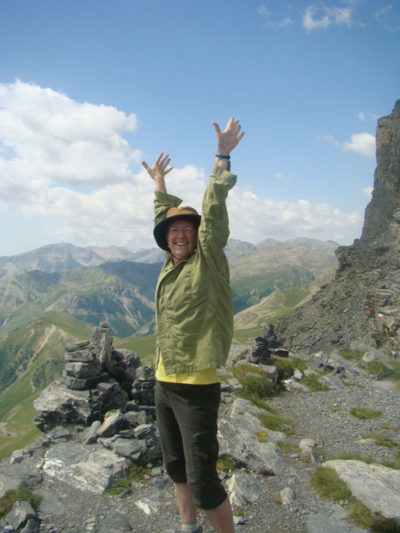
Day hiking is a minimalist’s dream. You don’t need to learn anything, and—aside from a good pair of hiking boots—you don’t have to buy anything. Planning is a cinch: You just go when and where the spirit moves you. As for fitness, this low-impact sport also just happens to be a powerful calorie-burner—a vigorous hike consumes nearly as many calories as a 5-mph jog.
And, if you’re new to fitness, you can start slow and go at your own pace until you build up more stamina. The point of the exercise is experience, not a race to the finish. “The good thing about hiking is that you can always slow down and rest,” says Peter Olsen, spokesperson for the American Hiking Society. “If you’re not having fun because the hike is too hard, sit down and look around. That’s also when you’ll actually see things like deer and birds.”
Hiking on the Cold Spring trail near her home in Santa Barbara, California, Melissa Keyes soaks in the changing seasons, making frequent stops along the way to observe flowers and a chubby, iridescent-yellow banana slug. The air is scented with bay leaves and sage, which grow wild along the path.
Where Michele is a hiking soloist, Melissa prefers company on her excursions. She began hiking about 20 years ago with her son. “We’d discover plants and animals together,” says the 54-year-old. “It was a way to get outdoors and introduce him to nature.”
With her son now grown, Melissa hits the trail with a group of new friends she met through meetup.com. It’s a supportive cluster of fellow outdoors-types that makes newcomers feel right at home. “Our hiking group is about being all inclusive,” she says. “It doesn’t matter what your fitness level is, we make sure everyone has a good time. Hiking helps us put life in perspective.”
“I wasn’t a hiker or an outdoor person until I retired,” says Norm Kleifgen, 74, of Cumberland, Indiana. Norm got his hiking start out of sheer restlessness: “I spent my entire life in an office and didn’t want to sit around the house all day.”
He’s since become an avid bird watcher. Unless the weather is severe, Norm hits the trail seven days a week. He brings a camera, binoculars, and a notebook so he can jot down his sightings. He has several trails he likes to follow, but his favorite local hike is at Fort Harrison, a former military installation converted to a state park. There, especially in the spring months, he watches for migrating warblers along with the usual suspects—robins, cardinals, and the like. Over the years, his hobby has taken him on hikes throughout North America where he’s snapped photos of moose and bears.
For Norm, hiking is about the magic of the wildlife—but it’s also more than that. “When I’m outside, I just feel stronger,” he says.
Get Started
A beginner’s guide to gearing up for your first hike.
Ready to try a day hike? The key is to start slowly, says Mark Fenton, author of The Complete Guide to Walking: For Health, Weight Loss, and Fitness. For a first hike, don’t plan to be out more than a few hours. And remember, it’s not a competition. Don’t push yourself: Olsen suggests using “the talk test” as a gauge for pace and intensity. That is, you should be able to carry on a conversation as you trek along. (If you can’t, slow down.) And be sure that your clothes are comfortable. “All your gear—shoes and clothes—should have been worn before and broken in,” says Fenton. Here are additional suggestions from the experts:
Find the right shoe
 The key is to buy a hiking shoe that suits your activity level. Olsen recommends cross-trainers or running shoes for level paths and hiking boots for rougher terrain. If you can spare the time, he suggests buying boots at an outdoors specialty shop where you can be fitted by trained staffers.
The key is to buy a hiking shoe that suits your activity level. Olsen recommends cross-trainers or running shoes for level paths and hiking boots for rougher terrain. If you can spare the time, he suggests buying boots at an outdoors specialty shop where you can be fitted by trained staffers.
Don’t skimp on socks
 While at that specialty store, pick out some hiking-specific socks. The best are made of synthetic material that has strong wicking action to keep your feet dry.
While at that specialty store, pick out some hiking-specific socks. The best are made of synthetic material that has strong wicking action to keep your feet dry.
Stay wet
 Always carry water. As much as you can. People tend to underestimate their water needs. Experienced hikers often tote a few extra gallons in their car to the trail head so they can drink immediately after the hike.
Always carry water. As much as you can. People tend to underestimate their water needs. Experienced hikers often tote a few extra gallons in their car to the trail head so they can drink immediately after the hike.
Be safe
 You shouldn’t expect to get lost—but no one who gets lost plans to do so. Bring along a daypack with a whistle, map, compass (or GPS), flashlight, matches, first aid kit, knife, and flashlight.
You shouldn’t expect to get lost—but no one who gets lost plans to do so. Bring along a daypack with a whistle, map, compass (or GPS), flashlight, matches, first aid kit, knife, and flashlight.
Select a few tools
 Beyond basic safety equipment, what you’ll need depends on where you plan to hike. Saul Staten, for example, a regular hiker at South Mountain Park in Phoenix, Arizona, always carries needle-nose pliers. “If you brush up against a cactus, the needles go right through your clothes,” he says. “Each needle has little microscopic hooks, and you have to pull them out carefully.”
Beyond basic safety equipment, what you’ll need depends on where you plan to hike. Saul Staten, for example, a regular hiker at South Mountain Park in Phoenix, Arizona, always carries needle-nose pliers. “If you brush up against a cactus, the needles go right through your clothes,” he says. “Each needle has little microscopic hooks, and you have to pull them out carefully.”
Support yourself
![]() This one’s optional, but Olsen suggests using trekking poles on rugged, natural trails. The lightweight poles ease the impact on knees and help maintain balance. Look for adjustable poles because one size doesn’t fit all.
This one’s optional, but Olsen suggests using trekking poles on rugged, natural trails. The lightweight poles ease the impact on knees and help maintain balance. Look for adjustable poles because one size doesn’t fit all.
Dress the part
![]() On trails with scrub or thistles on underbrush, wear pants. On wide trails or rail trails—a network of trails from former rail lines—shorts are more comfortable. Newer specialized hiking clothing—shirts, shorts, and pants—is designed with built-in high-tech properties such as bug repellent and sunscreen.
On trails with scrub or thistles on underbrush, wear pants. On wide trails or rail trails—a network of trails from former rail lines—shorts are more comfortable. Newer specialized hiking clothing—shirts, shorts, and pants—is designed with built-in high-tech properties such as bug repellent and sunscreen.
Trail-Finders
Looking for a place to hike? The following websites are loaded with useful information.
Americantrails.org: Nonprofit dedicated to maintaining trails for hiking, bicycling, skiing, and other activities. Posts information on National Historic and National Recreation Trails as well as trail planning and facilities.
Americanhiking.org: Lists clubs throughout the country promoting foot trails and hiking experiences.
Trails.com: For $49.95, you can access maps of more than 49,000 trails, driving directions, and more.
Localhikes.com: Site lists local trails in your area complete with information on length, hike time, and difficulty—and reviews from hikers.
Trailsource.com: Find more than 1,500 trail descriptions, maps, GPS downloads, and more. Offers free information, but—for an annual fee of $29.99—you can get access to unlimited premium content and information.